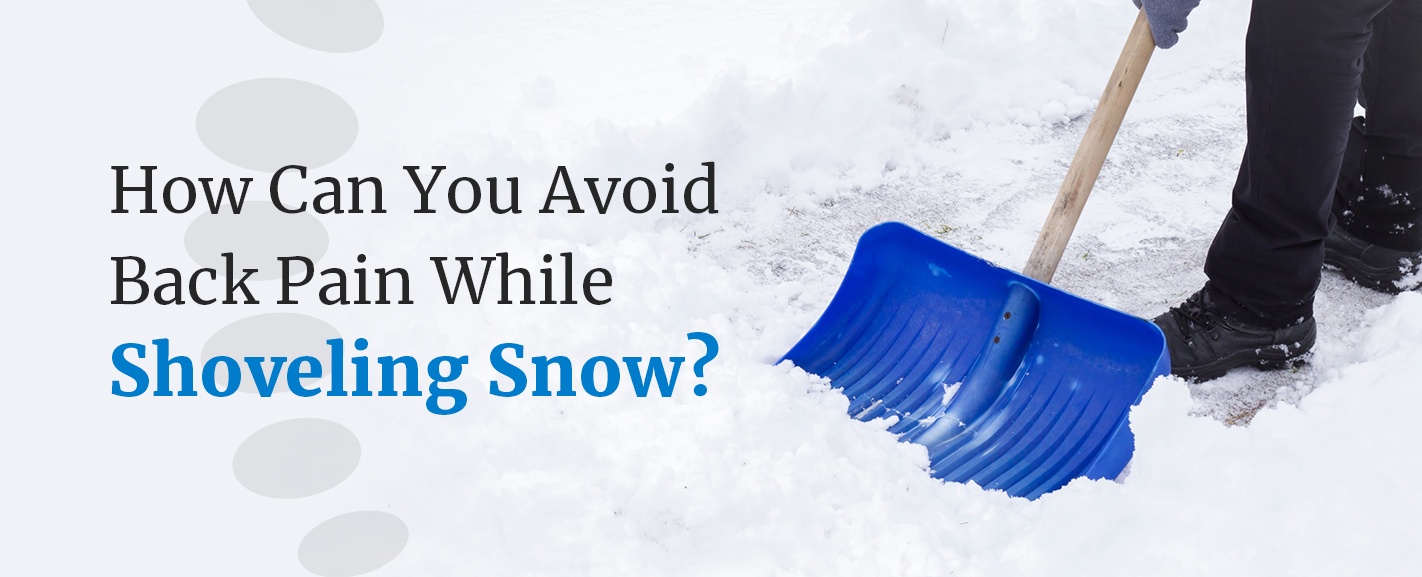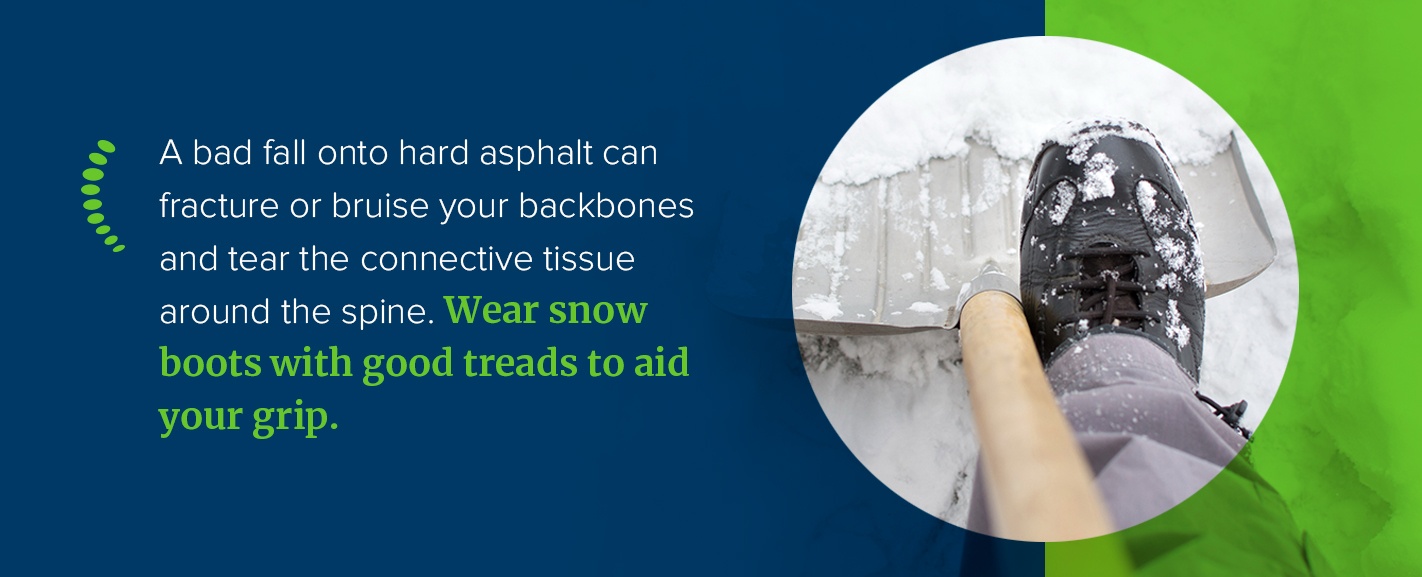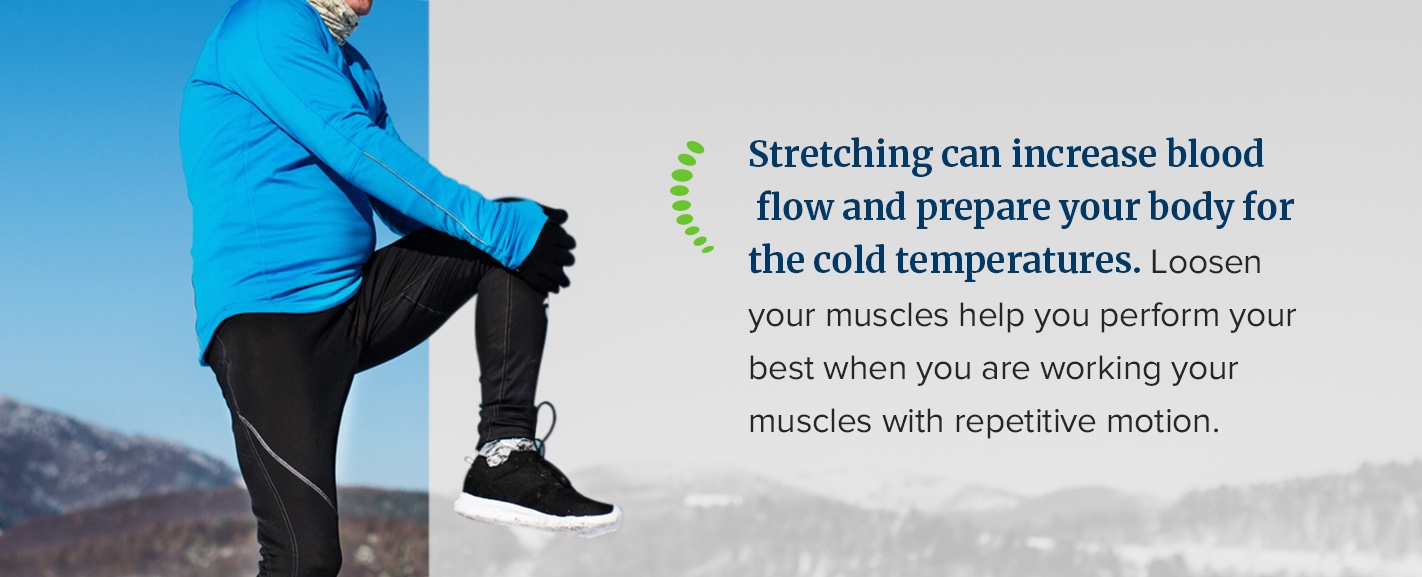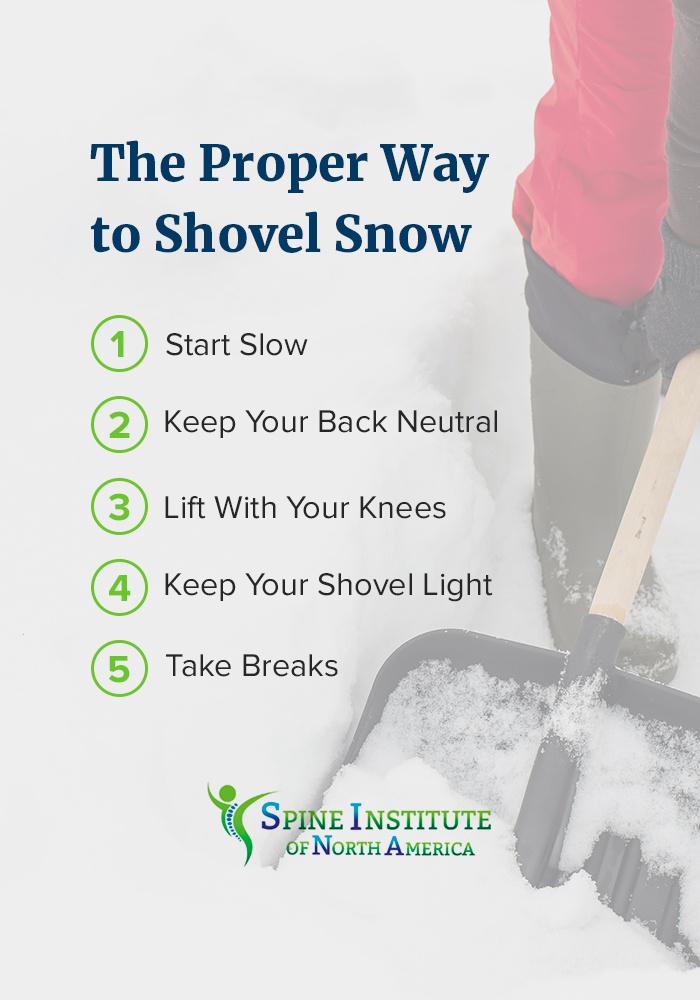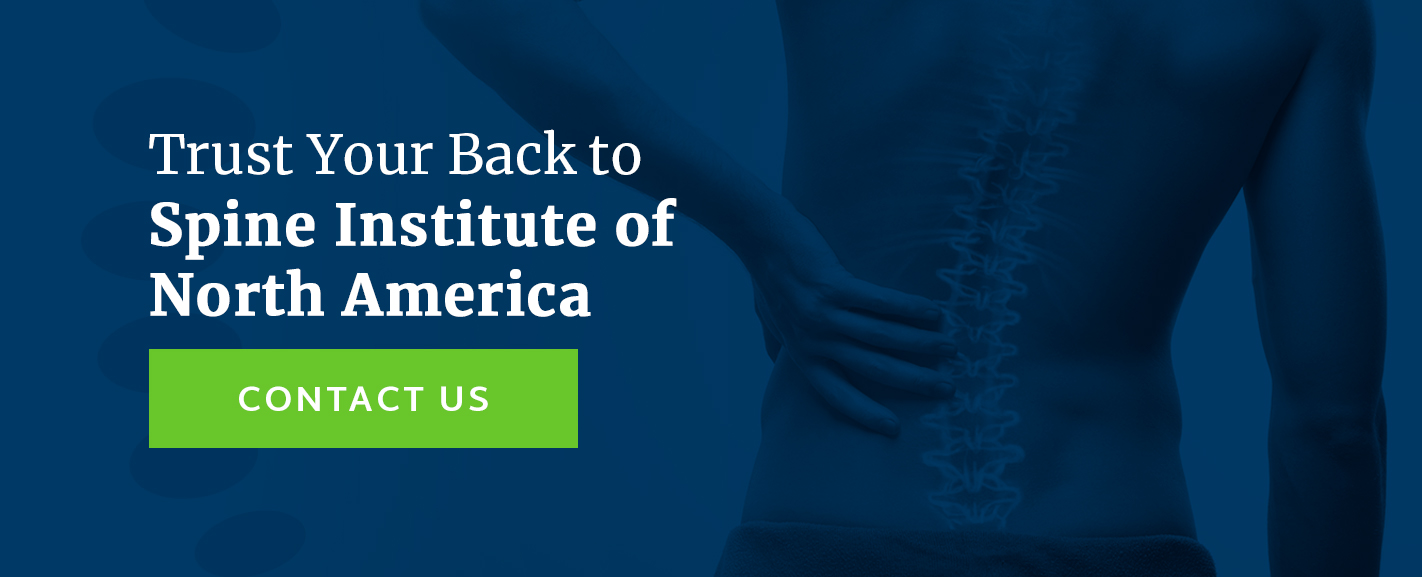This content was medically reviewed by Baher S. Yanni, MD, on January 17th, 2020.
Shoveling snow is an unavoidable reality for those of us in snowy regions. And when the flurries start coming down, many of us start to dread the soreness and pain in the upper or lower back that accompanies snow removal. While thousands of people suffer from snow-shoveling injuries each year, you can easily avoid back pain and injuries with a few simple tips.
If you take a few precautions, you can minimize sore muscles, avoid throwing out your back and even prevent some more severe injuries. By stretching, practicing proper form and taking frequent breaks, you can clear your driveway pain-free and enjoy more time with loved ones.
What Are the Most Common Injuries Which Can Occur While Shoveling?
Most snow-related injuries happen after overexertion or from slipping on ice while shoveling. While acute musculoskeletal exertion — in other words, overworking your muscles — accounts for most shoveling related injuries, some are due to slips and falls. Less common, but still significant, are the risks of being struck by a shovel. But, these injuries happen most often among roughhousing children than those using shovels for their intended purpose.
Regardless of the cause, it’s no surprise that injuries to the back are the most frequent snow shoveling injuries. The average person with a double driveway will shovel between 1,100 and 1,500 pounds of snow after a snowfall of six inches. The repeated movement can be hard on your back, especially your lower back. Here are the five most common snow shoveling injuries you’ll need to watch out for:
1. Lower Back Pain or Strain
Poor posture and a rounded back contribute to lower back pain because it will cause you to do more work with weaker muscles and overstretch the ligaments in your spine. You should always shovel snow with your back’s erector muscles, so make sure to keep a straight back, lift with your knees and push snow rather than lift it whenever possible.
3. Muscular Back Pain
Cramped, overtired and spasming muscles are more frequent during cold weather because the temperature restricts blood flow. Muscular back pain can occur in your lower back, your upper back or your shoulders. It is crucial to keep proper form so you don’t aggravate these muscles and warm-up before shoveling to increase blood flow.
2. Herniated Discs
A bulging or herniated disc occurs when one of the discs in your spine moves out of alignment and pinches a nearby nerve. These injuries are prevalent during heavy snowfall, where shovelers attempt to lift heavier loads. If you twist your spine instead of practicing a fluid up and down motion, you might slip a disc. To prevent slipped discs, always keep your knees perpendicular to the snow you want to lift and pivot or walk toward your pile to deposit it. Try not to throw snow over your shoulders or to the side. While this may feel like a time-saver, you’re much more likely to throw your back out shoveling snow this way.
4. Fractures, Torn Ligaments or Tendons and Bruising
A bad fall onto hard asphalt can fracture or bruise your backbones and tear the connective tissue around the spine. When it’s wet and cold, pay special attention to icy areas and move with caution. Wear snow boots with good treads to aid your grip and spread sand, salt or kitty litter on the sidewalk and driveway to increase your traction.
5. Sciatica
While not technically an injury, sciatica, or radiating nerve pain down the leg, can be exacerbated by activities such as shoveling snow. Herniated discs and muscle spasms can both cause sciatica, and treating these conditions can help you find relief. Cold weather puts you at greater risk for a muscle sprain, which can activate sciatic pain. A sudden movement, like lifting a shovel, can also worsen sciatica, so make sure to keep your actions fluid and warm up before shoveling. Wearing warm layers can also help.
Who Is Most At Risk of Injury When Shoveling?
Anyone who isn’t using proper form and taking care of their body is more likely to get injured while shoveling. A nearly 20-year study from The Center for Injury Research and Policy shows that about 11,500 are injured from snow-related incidents each year. About half of these are damage to the soft tissue, and about one third are localized in the lower back. This study also revealed who has the highest risk for injury during snow removal:
- People over 55 years old are more likely to get hurt during snow shoveling due to a fall. People in this age group account for over 21% of all snow shoveling related injuries each year.
- Men incur about two-thirds of annual snow shoveling injuries every year.
- Children are 15 times as likely as adults to be hit by a shovel. Of these injuries, most of them are blows to the head. Keep an eye on your kids or grandkids and discourage using shovels as toys.
How Can You Prevent Injuries While Shoveling?
The best medicine is preventative medicine, and back injuries are no different. Before you even pick up the shovel, you can do several things to prepare to clear your sidewalk and driveway. Taking care of yourself before you begin a physically demanding task like shoveling can help you avoid injury and lessen your body’s exertion.
1. Start Later in the Day
You are more likely to sustain a back injury in the morning. Your spinal discs naturally swell at this time of day, and your muscles are stiff since you aren’t active during sleep. You will also have a slower reaction time in the morning, which may increase your fall risk.
So, enjoy that morning cup of joe, warm up with a hot breakfast and wait a few hours before you begin shoveling.
2. Eat Right
A healthy diet can help prepare your body for physical exercise. We recommend eating foods rich in protein and complex carbohydrates before shoveling snow. These foods will fuel your muscles with vital nutrients and give you the energy to sustain yourself. Protein and complex carbs are packed with amino acids and will hydrate your muscles to help you recover quickly.
Breakfast foods chock-full of complex carbs proteins include oatmeal, low-sugar Greek yogurt and shredded wheat. Pair any of these meals with mangoes, blueberries, apples or bananas for an added dose of healthy carbs. You can also try sprouted bread, a nutrient-dense bread made with sprouted lentils and whole grains, for another protein and carb power-duo.
Diet alone will not prevent injury, but it’s an easy and tasty way to care for your body before hard work.
3. Stretch
Remember that clearing snow is strenuous exercise. As with any physical labor, a quick warm-up can go a long way. Stretching can increase blood flow and prepare your body for the cold temperatures. It will also loosen your muscles to help you perform your best when you are working your muscles with repetitive motion.
You can try a knee to chest stretch by laying on your back, pulling both of your knees to your chest, and holding for 20 to 30 seconds. You should feel this stretch in your lower back.
A spine specialist or physical therapist can recommend more stretches to target your back and keep you limber.
4. Dress Appropriately
Warm, loose layers and a thick outer shell can help you conserve heat during long hours in the cold. Sturdy boots with a solid outer sole grip will help you keep steady when working around ice patches. You should make sure to warm up in a well-heated house and eat a hot breakfast before shoveling to brace yourself for the cold.
Since cold weather constricts blood flow to the muscles, a quality winter coat, snow pants and insulated boots can help keep oxygen circulating to where your body needs it most. It will also keep you toasty and comfortable so you can get back inside and enjoy the rest of your day sooner.
5. Invest in an Ergonomic Snow Shovel
Most snow shovels don’t aid your comfort and safety. Some are heavy, and most do not offer adequate grips for your hands or a shape that gives additional leverage. Studies show that shovels with longer poles, adjustable lengths and curved shafts can help you bend less and lower your risk for injury. If you find that you’re in pain every time you shovel, a light-weight ergonomic shovel handle is sure to lighten your load.
What Is the Proper Way to Shovel Snow?
Once you have your shovel in hand, proper form is essential. Twisting your back can lead to a slipped disc, and poor posture can put unnecessary strain on your lower back. Make sure you’re putting your strongest muscles to work when you shovel! Here’s how you can keep your back in tip-top shape as you clear your driveway:
1. Start Slow
For the same reason you’ll want to stretch before you start moving, you don’t want to go too fast or lift too much once you begin. Overworking yourself will cause your muscles to fatigue, which may lead to an injury, or make you too tired to clean your entire driveway. Instead, ease yourself into shoveling so you can loosen up and get into a groove as you work.
2. Keep Your Back Neutral
Your back has a natural curve, and the best way to keep yourself from damaging your spine is to maintain that curve while shoveling. If you keep your back too straight or exaggerate your back’s curve, then weaker muscles will be bearing more of snow’s weight. Don’t try to flatten out your lower back or flex it forward, as this may cause an injury.
3. Lift With Your Knees
Your thigh muscles can lift a lot more than your back muscles. When you scoop up snow, bend at the knees, not the back, so that you are squatting. Squats allow you to lift with your stronger quadriceps and surrounding leg muscles. Using a wider stance and keeping one leg in front of the other will also help you gain leverage.
4. Keep Your Shovel Light
The more weight you try to lift, the more stress you will place on your back. Know your limits, and do not try to lift more than you can sustain for long periods. Instead of digging down to the asphalt and up-heaving a lot of snow at once, take it piece by piece and skim off the top layer first.
You may want to avoid lifting altogether by pushing snow off to the side and using your shovel like a plow rather than lifting heavy snow. If you must do some lifting, it’s best to alternate between hoisting and pushing snow.
5. Take Breaks
As with any workout, taking frequent breaks can prevent muscle fatigue and restore your energy. A good rule of thumb is to take a 30-second break for every five minutes of shoveling. When you take a break, use that time to stretch. Since you will be leaning forward while shoveling, you can counteract this motion by stretching backward, away from the muscle you’re putting stress on.
What Should You Do After a Back Injury?
Taking the precautions above should help you shovel snow pain free. But what do you do if you hurt or throw out your back?
The first step is to determine how urgent your injury is. Are you experiencing muscle soreness or something deeper? If you suspect a fracture or an injury to the spine, you should seek immediate medical attention.
If your pain is the result of a fall, do not try to continue shoveling, and instead consult a doctor to find a treatment option that will work best for you.
A herniated disc can lead to permanent nerve damage if left untreated, so make an appointment with a spine specialist as soon as you can.
If it’s not an emergency, there are a few things you can do to relieve your back pain.
How Do You Relieve Back Pain From Shoveling Snow?
Some minor low back pain after shoveling snow is not usually something to worry about. If it persists for more than a few days, consider making an appointment with your doctor. However, you can take some steps to relieve sore muscles in the back on your own.
1. Alternate Cold and Hot
Ice, especially on the first day or so after an injury, can help reduce pain and inflammation. We recommend applying ice for 20 minutes at a time using a towel as a buffer for your skin. Heat, when used to treat back pain, increases blood flow and relaxes sore muscles.
A warm bath with a scoop of Epsom salt can provide the most relief. The magnesium in the salt will absorb into your body and help flush out lactic acid, a substance your muscles produce after physical activity. Alternating ice and heat is especially useful because cold constricts blood flow and reduces inflammation, while heat increases blood flow to relax the muscles.
2. Gently Exercise the Affected Muscles
When you’re in pain from overworking your muscles, it may sound counter-intuitive to get them moving again. While rest is essential to recovery, some exercise will keep your muscles loose and break up knots. Try a short walk or some stretches that target the painful area. A foam roller session will soothe tender and stiff muscles with a gentle massage.
Generally, stretching away from the painful area will bring the most relief. Since shoveling requires leaning forward, a deep backward backbend can help you relieve muscle pain.
3. Get Some Rest
If you’re feeling sore after shoveling snow, rest can help your muscles recover. Avoid more shoveling or any activity that forces you to move these same muscles. It is normal to feel some soreness even three days after shoveling, so taking it easy for those first few days can help you bounce back.
If your pain persists for more than 72 hours, it’s time to seek medical help.
Trust Your Back to Spine INA
If you’ve sustained a back injury this winter while shoveling, using a snow blower or slipping on ice, you may be wondering what to do. At Spine INA, we can help you treat sciatica, low back injuries, shoulder pain, muscle soreness and more. Our caring and dedicated doctors can help relieve your pain and revive your life. We use the least invasive procedures, and value honesty and transparency so you can find the treatment options that work best for you.
See how we transform the lives of our patients and give them hope by watching some of our patient testimonials. If you’ve recently hurt yourself while shoveling snow, or are looking to manage your back pain, get in touch with our office today.
Source List:
- https://www.nationwidechildrens.org/research/areas-of-research/center-for-injury-research-and-policy/injury-topics/sports-recreation/snow-shoveling
- https://www.ncbi.nlm.nih.gov/pubmed/20825768
- https://orthoinfo.aaos.org/en/staying-healthy/prevent-snow-shoveling-and-snowblowing-injuries/
- https://redefinehealthcare.com/three-tips-for-overcoming-back-pain-while-shoveling-snow/
- https://www.spinemd.com/news-philanthropy/5-tips-to-overcome-the-post-shovel-aches-and-pains
- https://www.medicalnewstoday.com/articles/29108.php#cold_therapy
- https://www.besthealthmag.ca/best-you/arthritis-and-pain/shovelling-snow-back-pain/
- https://heattrak.com/blogs/homeowner/back-problems-associated-with-shoveling-snow
- https://www.healthline.com/health/herniated-disk
- https://www.urmc.rochester.edu/patients-families/health-matters/december-2017/watch-your-back-avoid-injury-while-shoveling-snow.aspx
- https://spineina.com/conditions/back-pain/lower-back-pain/
- https://spineina.com/conditions/back-pain/bulging-herniated-disc/
- https://spineina.com/sciatica/
- https://www.spineuniverse.com/blogs/hawkinson/can-weather-affect-sciatica
- https://www.myerowitzchiroacu.com/back-injuries-and-sciatica/
- https://www.eatthis.com/best-carbs-for-breakfast/
- https://spineina.com/blog/health-friendly-breakfast-foods/
- https://spineina.com/blog/back-pain-relieving-exercises/
- https://www.webmd.com/a-to-z-guides/news/20110120/snow-shoveling-injures-thousands-each-year#2
- https://spineina.com/treatments/
- https://spineina.com/testimonials/
- https://spineina.com/contact/
